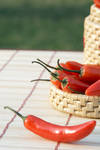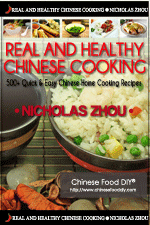



   
 


|

|
Home
> Cooking Tips
> Glossary > Glossary
M - R
Glossary
M - R
|

Chinese Cooking
Glossary
|
|
|
|
|
[Back
to Glossary Index]
M
Mangetout -
The
French word for snow peas, which means "eat it
all." See also snow peas.
Mangosteen
- Along with durian, mangosteen is one of the
two most popular Asian fruits. However, unlike
Durian, which is a yang or hot food, mangosteen
is thought to have cooling, yin properties. The
fruit of an evergreen tree native to Malaysia
and Indonesia, the mangosteen is often available
in Asian markets when in season. The ripe
mangosteen is roughly the same size as a
mandarin orange, with a reddish-purple rind. An
interesting fact about this fruit is that there
is always a type of scar at one end. This is a
remnant of the flower, and the number of remnant
flower parts contained in the scar will tell you
precisely how many segments of fruit are inside.
Besides containing more fruit, those with the
most segments will have fewer seeds. The fruit
itself is sweet, with a texture that has been
likened to a ripe plum. The flavor is sweet with
a hint of acidity.
When purchasing mangosteen fruit,
look for ones that are dark purple or reddish
purple but not blue-black in color. At home,
store mangos at room temperature and eat within
a few days. Also, it's important to remember
that unlike mangos, the mangosteen can't be
frozen. Mangosteens are commonly eaten raw as a
dessert.
Maraschino
Liqueur - A cherry liqueur made from
Maraska cherries grown in Dalmatia. They are
sour cherries, tasting a bit like bitter
almonds. 30 per cent alcohol by volume.
Maraschino
Cherry -
Dalmatian bitter wild cherry
tree bearing fruit whose juice is made into
maraschino liqueur.
Mochiko - Japanese for
glutinous rice flour. You'll frequently find
references to mochi, mochi flour, or mochiko
flour in Hawaiian recipes.
Monosodium Glutamate
- Please refer to MSG.
MSG -
MSG
stands for Monosodium Glutamate.
It is a white crystalline compound used to
enhance flavor.
** Please note that MSG may not be suitable
for everyone. Please visit
FDA for more information.
Whenever we mention MSG in
our ingredients, it is always optional.
Mushrooms, Chinese Black -
These are the dried mushrooms you'll
often find sold in bins in Asian markets. The
name is a bit of a misnomer, since Chinese black
mushrooms can be light brown, dark brown, and
even grey. They are frequently speckled.
Chinese black mushrooms (also known as shiitake
mushrooms) range in price from moderate to quite
expensive. The more costly are often called
"flower mushrooms" as they have a thick cap and
a nice curl. However, the cheaper brands are
perfectly acceptable for use in soups and
stir-fries.
While fresh black mushrooms may be
available, dried black mushrooms are preferred
for use in Asian recipes, as the drying process
gives them a stronger flavor. At home, store the
dried mushrooms in a container at room
temperature. They will last indefinitely.
Before use, soak them in warm water for between
twenty and thirty minutes, and remove the stems.
You might also want to strain them through a
sieve to remove any sand or dirt. The Chinese
believe black mushrooms may be helpful for
persons with high blood pressure.
Mushroom
Soy Sauce -
Soy sauce
that has been infused with the flavor of straw
mushrooms.

N
Napa Cabbage -
Brassica Pekinensis. While several types of
Chinese cabbage exist, the variety we most
commonly associate with Chinese cabbage is Napa
Cabbage, the large-headed cabbage with the
firmly packed, pale green leaves that you'll
usually find next to bok choy in western
supermarkets. It is also known as Peking Cabbage
and celery cabbage. More healthful than western
cabbages, Napa Cabbage is rich in Vitamin C and
other nutrients. Look for firm green leaves
that are not wilted or eaten by bugs. Store in a
plastic bag in the crisper section of the
refrigerator. Like tofu, Napa Cabbage absorbs
the flavors of the foods around it. It is eaten
raw in salads, and often added to stir-fries and
soups in the last stages of cooking. Cooking
Tip - Lining a bamboo steamer with Napa
Cabbage helps prevent food from sticking to the
bottom.

O
Oil Poaching -
A "trade
secret" used by many restaurants to give the
meat a more tender texture, oil poaching (also
called velveting) seals in the juices of the
meat. After marinating, heat between 2 - 4 cups
of oil in the wok to a temperature of about 325
degrees Fahrenheit, and immerse the marinated
meat in the hot oil for several seconds. Remove
the meat from the wok, drain, and cook further
as called for in the recipe.
Olive Oil - Extra Virgin Olive Oil has a
full, fruity flavour and the lowest acidity.
Virgin Olive Oil is slightly higher in acidity
and lighter in flavour. Pure Olive Oil is a
processed blend of olive oils and has the
highest acidity and lightest taste.
Oyster Sauce
- A
rich sauce made from boiled oysters and
seasonings, oyster sauce does not have a fishy
taste at all (boiling the oysters takes care of
that). This rich sauce with a savoury flavor is
used in meat and vegetable dishes, and is an
important ingredient in Cantonese cooking.
Oyster sauce brands have a wide price range;
steer clear of the cheaper brands if possible,
as they usually contain MSG.
Although the Buddhist vegetarian
diet does permit the eating of oysters,
vegetarian brands, often using mushrooms as a
substitute, are available. Oyster sauce is
normally sold in bottles; refrigerate after
opening. If purchased in a can, transfer to a
closed jar and refrigerate.

P
N/A

Q
N/A

R
Rice Vinegar -
Chinese
rice vinegars are milder and less acidic
than regular vinegar (as are Japanese
vinegars). There are three basic types - black,
red and white -as well as sweetened black
vinegars. The black variety is somewhat similar
to balsamic vinegar, while red vinegar has both
a sweet and tart taste. White vinegar is the
closest in acidity and flavor to regular
vinegar. There are no hard and fast rules, but
black vinegar is generally recommended for
braised dishes and as a dipping sauce, red
vinegar for soups, noodle and seafood dishes,
and white for sweet and sour dishes and for
pickling. In recipes,
rice vinegar is sometimes
also called "rice wine vinegar." Buy
rice vinegars
Rice Wine - Known
colloquially as "yellow wine," rice wine is a
rich-flavored liquid with a relatively low
alcohol content that is made from fermented
glutinous rice or millet. Aged for ten years or
more, rice wine is used both in drinking and
cooking. Since ancient times, the best and most
famous rice wines have come from Shaoxing in the
Zheijang province. (If you can't find rice wine
listed in the ingredients section of a Chinese
cookbook, try checking under "S"). Rice wine can
be found at Asian markets - steer clear of the
ones marked "cooking rice liquor" or "wine for
cooking" as these do not have the sweet taste of
authentic rice wine. If you do need a
substitute, pale dry sherry is acceptable, and
preferable to either sake (the Japanese rice
wine) or any other cooking wines. At home, store
the rice wine at room temperature, preferably
out of the light.
Buy rice wine

[Back
to Glossary Index]
|
Ready to cook Chinese food?
Get
ChineseFoodDIY's cookbook
"Real & Healthy
Chinese Cooking".
|
"500+ Healthy Chinese Recipes in 5 minutes"
|

|
ChineseFoodDIY's
cookbook "Real & Healthy Chinese Cooking" -
500+ low carb and low fat recipes with 170+ colorful pictures.
Based on a master chef's 40 years of cooking practice and 4 years of writing
and research, it has helped over 12,800 people worldwide improve
their health. All the secret copy cat recipes in ONE cookbook.
Click here to read the whole story that reveals how
ANYONE can cook delicious Chinese food and improve their health... in less than 20
minutes. | |
 |
|
|
|

|
|

|
|
